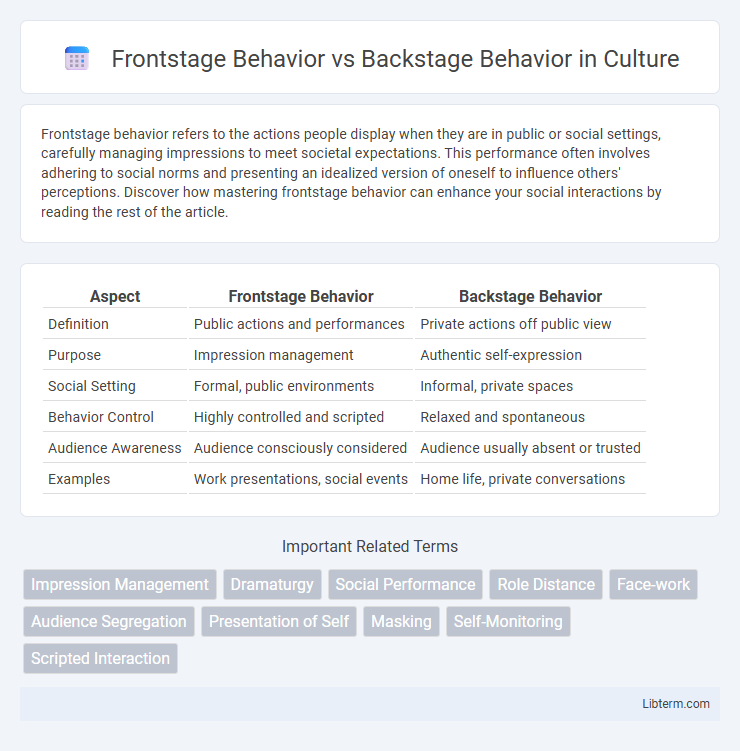Frontstage behavior refers to the actions people display when they are in public or social settings, carefully managing impressions to meet societal expectations. This performance often involves adhering to social norms and presenting an idealized version of oneself to influence others' perceptions. Discover how mastering frontstage behavior can enhance your social interactions by reading the rest of the article.
Table of Comparison
| Aspect | Frontstage Behavior | Backstage Behavior |
|---|---|---|
| Definition | Public actions and performances | Private actions off public view |
| Purpose | Impression management | Authentic self-expression |
| Social Setting | Formal, public environments | Informal, private spaces |
| Behavior Control | Highly controlled and scripted | Relaxed and spontaneous |
| Audience Awareness | Audience consciously considered | Audience usually absent or trusted |
| Examples | Work presentations, social events | Home life, private conversations |
Understanding Frontstage and Backstage Behavior
Frontstage behavior refers to the actions individuals present publicly, where they manage impressions and adhere to social norms, often performing roles expected by their audience. Backstage behavior occurs in private settings, allowing individuals to express themselves more authentically without the pressure of societal judgment. Understanding this distinction helps analyze how people navigate social interactions by balancing genuine self-expression with the need to conform to external expectations.
The Origins of Frontstage vs Backstage Concepts
The concepts of frontstage and backstage behavior originate from sociologist Erving Goffman's 1959 work "The Presentation of Self in Everyday Life," where he uses theatrical metaphors to analyze social interactions. Frontstage behavior refers to the actions individuals perform in public settings, aiming to create specific impressions for an audience, while backstage behavior involves private, unobserved moments where individuals can relax and express their true selves. These concepts reveal how people manage self-presentation and social roles in varying contexts to maintain desired images.
Key Differences Between Frontstage and Backstage Behavior
Frontstage behavior involves actions and presentations individuals perform in social settings where they are observed and evaluated by others, emphasizing impression management and adherence to social norms. Backstage behavior occurs in private, informal settings where individuals relax, express true feelings, and prepare for frontstage performances without concern for social judgment. The key differences lie in the level of self-monitoring, authenticity, and the presence or absence of an audience, influencing how behavior is manifested and controlled.
Examples of Frontstage Behavior in Everyday Life
Frontstage behavior involves actions and expressions individuals display publicly, such as smiling politely in a business meeting or engaging in small talk with strangers. Examples include a waiter maintaining a friendly demeanor while taking orders or a teacher projecting confidence during a lecture. These behaviors are carefully managed to align with social expectations and maintain a desired impression.
Examples of Backstage Behavior in Various Settings
Backstage behavior occurs when individuals relax their social masks and express their true feelings away from public scrutiny, such as a teacher venting frustrations privately to colleagues after class, employees discussing workplace grievances in break rooms, or politicians speaking candidly among trusted advisors behind closed doors. These instances reveal authentic attitudes and emotions that contrast with the frontstage performances maintained in formal or public environments. Backstage settings provide insight into genuine interactions that influence overall social dynamics and group relationships.
The Role of Social Norms in Shaping Behavior
Social norms critically influence frontstage behavior by guiding individuals to perform roles that align with societal expectations, ensuring appropriate impression management in public settings. Backstage behavior reveals more authentic actions and expressions as social norms typically exert less control, allowing individuals to relax their adherence to public role constraints. This dynamic interplay demonstrates how social norms regulate image construction, balancing public compliance and private authenticity.
How Frontstage Behavior Affects Personal Image
Frontstage behavior shapes personal image by influencing how others perceive an individual's professionalism, confidence, and social skills in public or professional settings. Consistent, positive frontstage performance enhances reputation and builds trust, leading to greater social and career opportunities. In contrast, discrepancies between frontstage and backstage behavior can result in perceptions of inauthenticity, impacting credibility and personal branding.
Psychological Impact of Maintaining Separate Behaviors
Maintaining distinct frontstage and backstage behaviors creates significant psychological tension due to the constant regulation of self-presentation in social interactions. This separation demands cognitive resources to suppress authentic feelings backstage, often leading to emotional exhaustion and identity fragmentation. Over time, the dissonance between public persona and private self can result in increased stress, anxiety, and a diminished sense of personal authenticity.
Frontstage vs Backstage in Professional Environments
Frontstage behavior in professional environments involves public interactions where employees perform roles according to organizational expectations, aiming to create positive impressions on clients and colleagues. Backstage behavior occurs in private settings where individuals relax professional facades, express authentic thoughts, and prepare for frontstage performances without external judgment. Understanding the distinction enhances workplace dynamics by balancing genuine self-expression with strategic professionalism.
Navigating Authenticity Between Frontstage and Backstage
Navigating authenticity between frontstage and backstage behavior requires understanding the distinct roles individuals perform in public versus private settings, where frontstage behavior is often tailored to social expectations and backstage behavior reflects genuine self-expression. Authenticity emerges through the careful balance of adhering to social norms while preserving personal values behind the scenes. This dynamic interplay influences identity management and emotional labor in interpersonal interactions.
Frontstage Behavior Infographic

 libterm.com
libterm.com